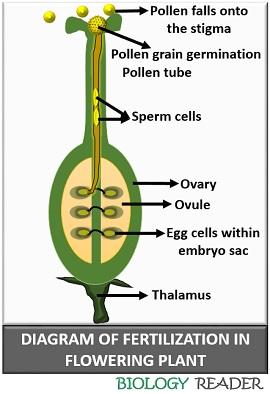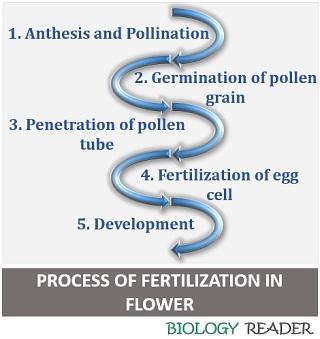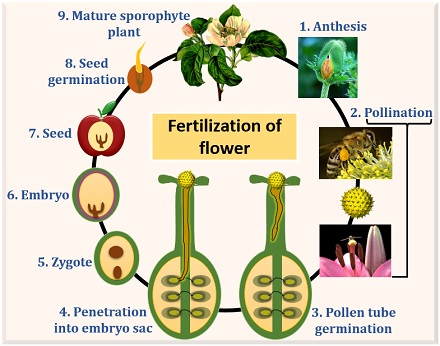Fertilization in flower is a type of sexual reproduction, where the flower’s male and female gametes fuse to form a zygote or fruit. In a flowering plant, pollen grains released from an anther containing two sperm cells or male gametes of the flowering plant. The flower’s ovary consists of a megasporangium or ovule, which includes a seven-celled embryo sac.
A three-celled egg apparatus, a central cell and three antipodal cells are present within the embryo sac. The egg apparatus contains egg cells or the female gametes within the embryo sac. Thus, plants also involve combining male and female gametes to form a zygote, like human fertilization.
For fertilization to occur, a process of pollination in flower is necessary. Without pollination, fertilization in the plants cannot be achieved. In this lesson, we will discuss the definition, process and significance of the fertilization process in flower.
Content: Fertilization in Flower
Definition of Fertilization in Flower
Fertilization in flower refers to the flower’s growth process that involves the fusion of sperm cells carried by the pollen grains and the egg cells in an ovule to form a zygote. In flowers, “stamen or androecium” is the male reproductive part, and “carpel or gynoecium” is the female reproductive part. The flower’s anther carries the male gametes or sperm cells within the pollen sacs or microsporangium.

The female gametes or egg cells reside with an ovule or megasporangium. By pollination, the pollen grains reach the top of the flower’s female reproductive part, i.e. stigma. Then, through the pollen tube germination, the passage of sperm cells to the egg cells become possible and eventually, fertilization occurs.
Process of Fertilization in Flower
A method of fertilization in flowering plant involves the following steps:

Pollination
First, the anthers elevate via elongated filaments. “Anthesis” refers to the process during which the anthers ultimately dangle out of the spikelet. After anthesis, pollination immediately occurs. During pollination, anther releases pollen grains containing the sperm cells.
Then, the pollen grains are transferred to the sticky stigma via some pollinating agents like wind, water and insects. The stigma also receives the pollen grains in the flowering stage or during the time of spikelet opening.
Germination of Pollen grain
Under favourable conditions, the pollens adhered to the stigma starts to germinate. On germination, a pollen grain forms a germ tube or pollen tube. The pollen tube acts as a passage from the stigma to an ovule.
Penetration of the tube into the ovule
The pollen tube first penetrates the stigma and grows downwards from the style to an ovule and finally the micropyle region of an embryo sac. The sperm cells carried by the pollen grains are released into the tube, which ultimately penetrates an ovule wall.
Generally, it takes 15-16 minutes for the pollen tube to reach an ovule. The entry of the pollen tube to the embryo sac is called “Pollen-pistil interaction”.
Fertilization
It involves the fusion of the flower’s male and female gametes. The embryo sac contains seven cells, one egg cell, synergid, two polar nuclei and three antipodal cells. A pollen tube enters one of the synergids and discharges its sperm cells.
One sperm cell or male gamete fuses with the egg cell to form a diploid “Zygote”. The other sperm cell fuses with the two polar nuclei to develop a triploid primary endosperm cell. Thus, the fusion of the male gametes with an egg cell and polar nucleus refers to the process of “Double fertilization”.
Development
A zygote develops into an embryo, and a primary endosperm cell develops into a nutrient-rich endosperm after it undergoes mitosis. The endosperm provides nourishment to the developing embryo. After fertilization and all the developmental stages, the ovule transforms into a seed, whereas the ovary transforms into a fruit.

Significance
A process of fertilization in flowers is an important growth event, which evolves new species by providing new genetic characters to the plant. Fertilization ensures the diploidy of the zygote by the fusion of haploid sperm cell and egg cell. It is essential for the formation of seeds and fruits.